One of Europe’s greatest treasures as you’ve never seen it before
To a stirring orchestral score and the sound of turning pages, animated animals, mythical creatures and biblical figures swirl around us, with Latin calligraphy and Celtic knots and crosses adding to the psychedelic visuals. This is the Book of Kells as you’ve never seen it before. Crafted by monks about 1200 years ago, written on vellum (calfskin) and coloured with natural dyes, this illuminated manuscript is one of the great treasures of medieval Europe. Only a few of its 680 pages are on public display at any one time as it’s kept in a climate-controlled case at the Old Library of Dublin’s Trinity College.
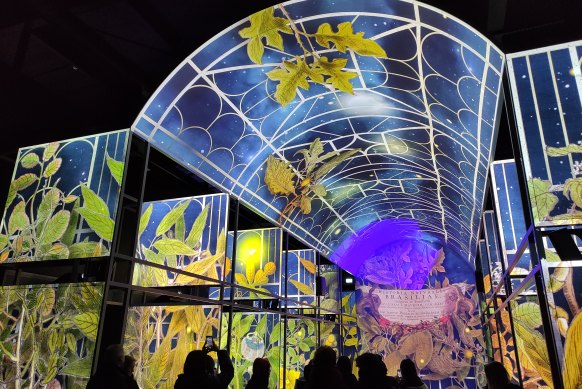
Spectacular audio-visuals shape the new Book of Kells Experience at Trinity College, Dublin.
But Trinity’s surreal new Book of Kells Experience flings open the precious manuscript digitally. Housed in a purpose-built, bright red metal pavilion on one of the college lawns, its dreamlike 360-degree projections reveal stories from the book’s four Christian gospels while plunging into its nail-biting history. A symbol of national pride in Ireland, the book was begun by Celtic monks living on the Scottish island of Iona.
One dramatic projection shows the holy men fleeing murderous Viking raiders and sailing across the choppy Irish Sea, settling in the serene, bucolic countryside of Kells, an abbey town in County Meath, 65 kilometres north of Dublin. Though the Vikings would soon pillage the Emerald Isle and establish settlements here, including Dublin in AD841, the fabled book eluded their clutches and was gifted to Trinity College in 1661.
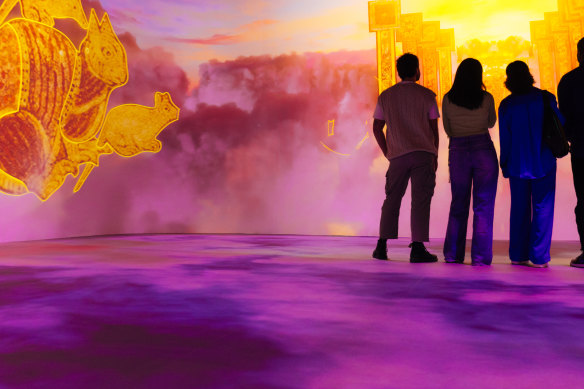
Mesmerising ... the Book of Kells Experience.
The pavilion also reimagines other Trinity marvels, notably the Old Library’s magisterial Long Room, with the contents of some of its prized books projected onto a smaller replica of this 65-metre-long chamber. We watch trees and leaves writhe from antique tomes about tropical plants before diving into the fantastical travels of Gulliver – a saga by Jonathan Swift, one of Trinity’s celebrated alumni. Quirkier still are the moving sculptures, with technology bringing to life characters portrayed in the Long Room’s marble busts. It’s spooky yet amusing observing Swift, Socrates, Shakespeare, Ada Lovelace and others having philosophical conversations as their lips move and eyes blink.
A combined ticket – from €33.50 ($56) – gives you entry to this pavilion and the Old Library (including a peek at the real Book Of Kells), plus a guided 45-minute campus tour. We’re led by Ethan D’Arcy, a final-year Trinity undergraduate, who explains that the university was founded in 1592 by Queen Elizabeth I of England on the ruins of a 12th-century monastery. Pointing out Trinity’s eclectic architecture, from neoclassical and Victorian gothic gems to brutalist and contemporary blocks, Ethan also shares anecdotes about illustrious past students, including Oscar Wilde, Bram Stoker and Sally Rooney, whose novel Normal People was adapted into a 2020 TV hit partly filmed on Trinity’s leafy grounds.
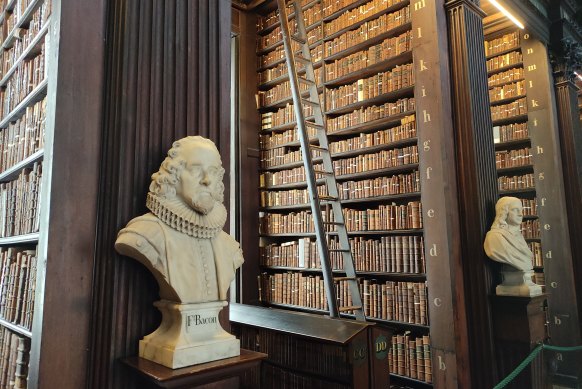
The majestic Long Room of the Old Library at Trinity College.
Like most Irish, it seems, Ethan is a gifted storyteller, although theoretical physics, not literature, is his subject (“Just think of Sheldon from Big Bang Theory,” says this likeable young man, who reminds me a little of Harry Potter, albeit with square rather than round glasses). Hogwarts springs to mind as I walk through the Old Library’s Long Room, a near 300-year-old wood-panelled wonder undergoing a painstaking €90 million renovation.
More than 200,000 rare books are being removed. Some shelves, ladders perched beside them, are already bare, their contents bagged, electronically tagged and stored for safekeeping (screens show library staff undertaking this process). Other shelves still heave with leather-bound volumes. But they too will be vacant before long, with work ongoing to modernise the Long Room’s environmental controls, helping to reduce dust and pollution and boosting fire-protection measures (plans were accelerated after the 2019 blaze at Paris’ Notre-Dame cathedral).
Even half-empty, the Long Room is utterly mesmerising, aided by Gaia, a huge revolving installation by British artist Luke Jerram. Flaunting detailed NASA imagery of Earth, it hangs from the barrel-vaulted ceiling above significant Irish relics, including the oldest, most intricately carved Irish harp in existence (you’ll see this willow and oak instrument depicted on Irish passports, euro coins and the Guinness logo).
The Long Room also exhibits an original copy of the 1916 Proclamation of Independence. This was drawn up by rebels championing Ireland’s release from British colonial rule – a feat partially achieved in 1922 when 26 of Ireland’s 32 counties formed a new free state that would evolve into a republic (the other six, in Northern Ireland, remain part of the United Kingdom).
Ireland had the fastest-growing economy in the European Union last year, with tech, finance and tourism driving Dublin’s post-pandemic resurgence. I count more lofty construction cranes than church spires as I dine on stone bass and seafood with smoked bomba rice, crispy nori and fennel at Sophie’s, a clubbable fifth-floor rooftop restaurant at the Dean Hotel, a groovy base in one of the city centre’s rows of beautifully preserved Georgian terraced townhouses.
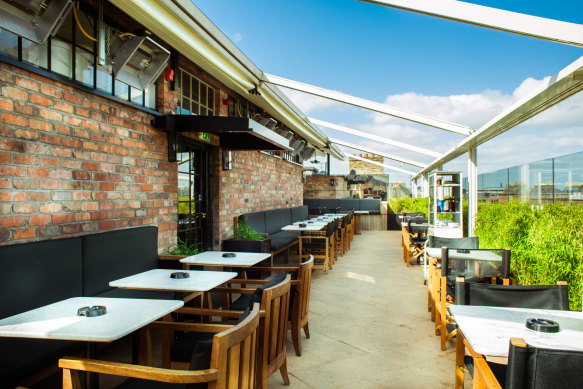
Sophie’s Rooftop Restaurant, Dublin City.
We stay across the street at the bookish Iveagh Garden Hotel, which overlooks a verdant, secluded park and touts itself as “Europe’s first sustainable hotel”, harnessing its power from a river 50 metres underground. Another day, we lunch at ALT at Wren Urban Nest, another of Dublin’s eco-minded hotels, which uses 100 per cent renewable energy, organic ingredients from ethical local producers and has a rooftop garden with bees, butterflies, beetles and wildflowers.
Despite a fervour for 21st-century trends such as lower carbon footprints, new city bike lanes and cosmopolitan fusion dining, many of Dublin’s charms are timeless, not least its glorious old pubs, including the bygone haunts of Wilde, Samuel Beckett and James Joyce. Ambling about town, dozens of addresses tempt you with their convivial craic, vintage decor and cosy mahogany nooks and lounges. Don’t miss Grogan’s, just outside the cobbled, tourist-thronged Temple Bar district.
The pub’s walls are lined with pieces by contemporary artists from Ireland and abroad – everything’s for sale, the displays change every six months – while multi-generational Dubliners mingle here over some of the world’s finest pints of Guinness.
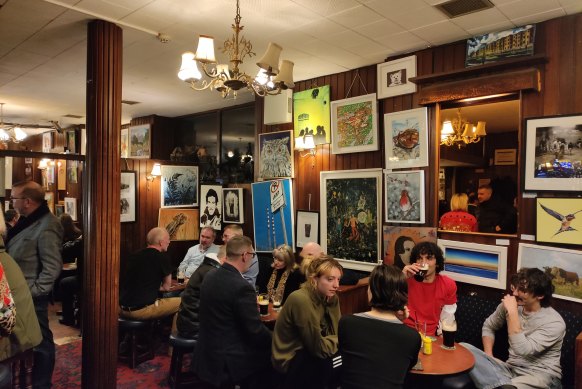
Grogan’s is known for its good craic and contemporary art.
To sample the black stuff at its source, hit the Guinness Storehouse, a mammoth attraction at the historic St James’s Gate brewery founded in 1759. Visitor offerings are always being tweaked, the latest addition to the excellent Storehouse tour giving a high-tech immersive insight into the four key ingredients – water, barley, hops and yeast – that fuel the legendary stout.
You can also try pouring a perfect pint at the Storehouse’s Guinness Academy, drink in the Dublin panoramas at the seventh-floor Gravity Bar and pair your tipple with oysters, hand-dived scallops (with samphire and nduja butter) or beef and Guinness stew at the brasserie. And if you fancy looking at yourself as you sip, bar staff can etch your selfie – or “stoutie” – onto the creamy head of your pint. Granted, it’ll fade as you drink it (and may warp almost Dorian Gray-like), but Dublin will be imprinted on your memory.
Five more Dublin highlights
Whiskey
Irish whiskey is enjoying a revival, with new distilleries mushrooming across the Emerald Isle, particularly in the Liberties enclave near the Guinness Storehouse. Visit them individually or sample the uisce beatha (water of life) on a distillery-hopping tour. See whiskeyisland.ie
Fine dining
For tasting menus serving Michelin-starred modern Irish cuisine, try Variety Jones, in the Liberties, or The Liath, run by Australian-born owner-chef Damien Grey in Blackrock, one of Dublin’s desirable seaside suburbs. See varietyjones.ie and liathrestaurant.com
Free culture
Catch live Irish bands and dancers at pubs such as Darkey Kelly’s and O’Donoghue’s Bar and works by esteemed Irish artists at the capital’s admission-free cultural draws. Jack Butler Yeats, Sean Scully and Mainie Jellett are showcased at the Hugh Lane Gallery and the National Gallery. See visitdublin.com
Castles
Beyond Dublin Castle – the Brits’ Irish powerbase for eight centuries – old fortresses and mansions dot the city’s outskirts, including the atmospheric (possibly haunted) Anglo-Norman pile of Malahide, set on a lush sprawling estate with botanical gardens. See malahidecastleandgardens.ie
Festivals
Dublin’s vibrant festival calendar peaks on St Patrick’s Day, when about 500,000 revellers jam pavements to watch marchers and performers on the annual March 17 parade. There’s also an event-packed festival quarter at Collins Barracks, a converted British army garrison by the hip Stoneybatter district north of the River Liffey. See stpatricksfestival.ie
THE DETAILS
FLY
Emirates flies to Dublin from Sydney and Melbourne via Dubai. See emirates.com
STAY
Rooms at the Iveagh Garden Hotel from €109 ($175). See iveaghgardenhotel.ie
MORE
ireland.com
The writer travelled as a guest of Tourism Ireland.
Sign up for the Traveller Deals newsletter
Get exclusive travel deals delivered straight to your inbox. Sign up now.